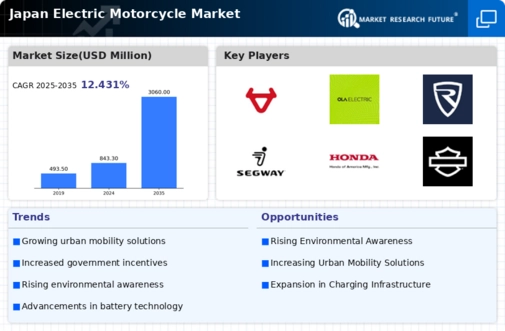Market Growth Projections
The Global Japan Electric Motorcycle Market Industry is poised for substantial growth, with projections indicating a market value of 1.5 USD Billion in 2024 and an anticipated increase to 12 USD Billion by 2035. This growth trajectory suggests a compound annual growth rate of 20.81% from 2025 to 2035, reflecting the increasing adoption of electric motorcycles. Factors contributing to this growth include technological advancements, government support, and changing consumer preferences towards sustainable transportation solutions. The market's expansion is likely to create new opportunities for manufacturers and stakeholders within the electric motorcycle sector.
Government Support and Incentives
Government support and incentives are pivotal in shaping the Global Japan Electric Motorcycle Market Industry. The Japanese government has introduced various policies aimed at promoting electric vehicle adoption, including subsidies for electric motorcycle purchases and investments in charging infrastructure. These initiatives are designed to encourage consumers to transition from conventional vehicles to electric alternatives. As a result, the market is expected to witness a compound annual growth rate of 20.81% from 2025 to 2035. This supportive regulatory environment is likely to foster innovation and investment in the electric motorcycle sector, further propelling market growth.
Rising Fuel Prices and Economic Factors
Rising fuel prices and economic factors are influencing consumer behavior in the Global Japan Electric Motorcycle Market Industry. As fuel costs continue to fluctuate, consumers are increasingly seeking cost-effective alternatives to traditional motorcycles. Electric motorcycles present a viable solution, offering lower operating costs and reduced dependence on fossil fuels. This shift in consumer sentiment is expected to drive market growth, with projections indicating a market value of 1.5 USD Billion in 2024. Economic considerations, coupled with the growing awareness of environmental issues, are likely to propel the adoption of electric motorcycles as a practical choice for budget-conscious consumers.
Growing Demand for Sustainable Transportation
The Global Japan Electric Motorcycle Market Industry is experiencing a notable surge in demand for sustainable transportation solutions. As environmental concerns escalate, consumers are increasingly seeking alternatives to traditional gasoline-powered vehicles. This shift is evidenced by the projected market value of 1.5 USD Billion in 2024, reflecting a growing preference for electric motorcycles. The Japanese government has also implemented various incentives to promote electric vehicle adoption, further driving consumer interest. This trend indicates a potential for significant growth in the industry as more individuals prioritize eco-friendly options in their transportation choices.
Increasing Urbanization and Traffic Congestion
Increasing urbanization and traffic congestion are driving factors in the Global Japan Electric Motorcycle Market Industry. As urban populations grow, the demand for efficient and compact transportation solutions rises. Electric motorcycles offer a practical alternative to traditional vehicles, allowing for easier navigation through congested city streets. This trend is particularly relevant in densely populated areas, where space is limited. The convenience and maneuverability of electric motorcycles are likely to attract urban commuters, contributing to the overall market growth. The anticipated expansion of the electric motorcycle market aligns with the evolving transportation needs of urban populations.
Technological Advancements in Battery Technology
Technological advancements in battery technology are playing a crucial role in the Global Japan Electric Motorcycle Market Industry. Innovations such as improved energy density and faster charging capabilities are enhancing the performance and appeal of electric motorcycles. As battery costs continue to decline, manufacturers are likely to offer more competitive pricing, making electric motorcycles more accessible to a broader audience. This trend aligns with the anticipated market growth, projected to reach 12 USD Billion by 2035. Enhanced battery technology not only improves the range and efficiency of electric motorcycles but also contributes to the overall sustainability of the transportation sector.























Leave a Comment